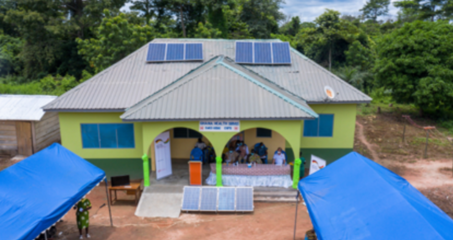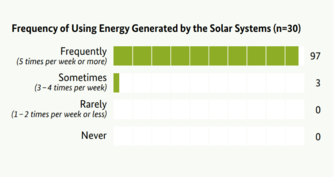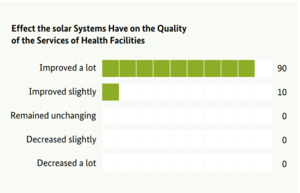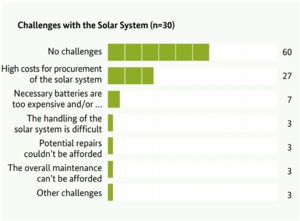Knowledge fuels change
For over a decade, Energypedia has shared free, reliable energy expertise with the world.
We’re now facing a serious funding gap.
Help keep this platform alive — your donation, big or small, truly matters!
Thank you for your support
Improving Health Services for the Rural Population in Ghana
Project Approach
In Ghana, around four million people, mainly living in rural areas, have no access to electricity. This has a significant negative impact on community facilities such as health clinics. Due to the lack of electricity, these clinics do not have the facilities to operate medical equipment for mother-child care, to stock medicines and vaccines, to receive patients at night or to manage patient data electronically. The staff employed work under pre-modern conditions. Thus, basic health care in these clinics is of modest quality. Improving access to decentralised renewable energy systems at social institutions such as rural clinics is crucial to the Ghananian government’s national policy. This applies in particular to Community-based Health Planning and Services (CHPS) in off-grid areas.
The objective of the Green People’s Energy (Grüne Bürgerenergie, GBE) project is to improve the conditions for rural communities to use renewable energy applications in their social infrastructure by supporting 31 clinics. The clinics were selected by the Ghana Health Service, the state-owned agency responsible for the operation and maintenance of around 500 rural clinics in Ghana, jointly with the Ministry of Energy and GBE. All sites, which are supported by the project are situated near the Lake Volta, in the Eastern Region, specifically in the Kwahu Afram Plains North and South with Donkorkrom and Tease as their respective district capitals. Each clinic operates with at least 2 nurses, who are supported by regular visits of technical and health supervisors from the district health authorities. This helps the on-site based staff managing the IT-equipped desk offices and operation of the day-to-day health service at all 31 clinics.
Before the intervention, the surrounding 89,000 villagers are only served during daytime and with very limited services. Deliveries at the clinics cannot take place without electric light. Pregnant women have to take the arduous journey on motorbikes or boats to the nearby district hospital to receive modern medical care. The project thus aims to improve community health, particularly for women in labour and newborns who need services and treatments during day and night The project develops a comprehensive strategy to equip the clinics with solar PV systems, vaccine refrigerators and street lights. Further activities include training of the Ghana Health Services engineering team and local clinic staff in the operation, maintenance and troubleshooting of the solar systems.
Methodology of Data Collection
The data for this case study report was collected through a review of project documents, five qualitative interviews with representatives of GBE, the Ministry of Energy, Deng Limited, the Ghana Health Service, and Abantu for Rural Development, a non-governmantal organization specialized in energy & gender issues, which was affiliated to the project, and a quantitative survey of 31 clinics. 30 of the clinics participated in the survey. The case study was conducted between January and June 2023. At that time, some project activities were still ongoing. As a result, the impacts captured are not exhaustive.
Key Findings
Project Achievements
Through public tender process, the local solar energy company DENG Limited installed 31 solar PV systems each of 2 kWp with a 2-day autonomy battery storage and 23 vaccine refrigerators under World Health Organisation standard. In addition, 44 solar powered street lights were installed by the local solar energy company PREFOS Ltd. The solar systems, with their battery storage, provide continuous power for the operation of medical equipment such as ultrasound sensors, sterilisers, monitors and IT databases, as well as for the lighting in the clinic and staff rooms and for the vaccine refrigerators supplied. The operation of these special energy-saving refrigerators with a freezer section makes it possible to have vaccines permanently in stock in order to carry out vaccination campaigns according to the prescribed schedule. The ice packs are used when medical staff go to the villages with mobile polystyrene boxes to vaccinate those who cannot make the trip to the clinic themselves. The presence of a permanently operational vaccination cabinet also means that clinics are now supplied with vaccines by the „Zipline“ drone service in emergencies, as the cold chain can be maintained. According to the survey results, 97% of the clinics use solar energy frequently, at least five times a week. In contrast, only 3% use it occasionally, between three and four times a week (see Figure 1).
Among the various purposes for which the clinics use solar energy, the most common ones are lighting (73%), electricity for communication (73%), cooling of rooms (60%), refrigeration/freezing for cold storage (60%), and powering other devices (37%). It’s worth mentioning that only a small percentage of clinics (3%) use solar energy for medical equipment, while 7% use it for other purposes and appliances.The survey also revealed that 73% of the clinics did not have access to electricity before, while 23% reported that they have switched to the new solar system and did have energy access beforehand. However, the capacity and possibilities for use of previous systems were very limited. The new systems have therefore undoubtedly made a significant contribution to improving health services in the target clinics.
By providing a reliable and sustainable source of electricity, the clinics are now able to operate around the clock and provide adequate lighting for their premises. The provision of solar energy has also facilitated the acquisition of modern medical equipment, including sterilisers and vaccine refrigerators. This has significantly improved the delivery of quality healthcare services to patients. Overall, solar energy has improved healthcare services and continues to play a major role in improving the overall well-being of the targeted communities.
Intermediate Impact
The solar-powered clinic project has had a significant impact on healthcare services, with 90% of the clinics reporting a major improvement in quality and 10% reporting a slight improvement (see Figure 2).
This progress has led to an increase in working hours – probably mainly due to night time shifts, with 87% of the clinics reporting a significant increase in working hours per week, while only 10% showed a slight increase, and 3% remained unchanged. 17% of the clinics also hired additional staff because of the new solar systems. As a result, 67% of the clinics reported a significant increase in the number of examinations, treatments and surgeries, 30% experienced a slight increase and only 3% have shown a decrease. The mostly increased numbers give reason to assume that patients value the improved health care they receive. The project also had a positive impact on the number of vaccinations offered, with 53% of clinics reporting a significant increase and 17% reporting a slight increase. Furthermore, the number of births in healthcare facilities has increased, with 37% reporting a significant increase and 23% observing a slight increase. All in all, this indicates improved medical care in the targeted rural communities.
Finally, the solar systems have had an impact on the overall number of people treated by health facility staff, with 80% of the clinics surveyed reporting a significant increase and 20% reporting a slight increase.
The installation of solar systems in clinics has had a positive impact on the community, providing access to advanced medical treatment through the use of various solar-powered appliances. Solar-powered refrigerators ensure the safe storage of vaccines and maintain their effectiveness. In addition, solar lights assist women in labour during nighttime deliveries. These achievements are expected to increase life expectancy of the community.
Climate Impact
Following the calculation methodology of the United Nations Framework Convention on Climate Change (UNFCCC), the installations described above are estimated to mitigate 73,69 t CO2 e/a in the year of installation by avoiding the use of fossil fuels. This is roughly equivalent to the annual CO2 emissions of more than 52 medium-sized cars in Germany.

Challenges
While the project has achieved significant successes and positive impacts, it has also faced some challenges. According to the results of the quantitative survey conducted, 27% of the clinics expressed concern about the generally high cost of purchasing solar systems. However, this project did not require clinics to contribute to the purchase, so it is reasonable to assume that these responses refer to other, possibly private or older, solar systems. 7% pointed out the expensive and frequent replacement of batteries as a major challenge. Moreover, 3% of clinics struggled with the handling of the solar system, and the same percentage felt that the cost of potential repairs was too high. A further 3% considered the maintenance costs to be unaffordable. Despite these challenges, it is foremost striking that 60% of the clinics did not encounter any obstacles during the project (see Figure 3).
Implementers faced several challenges during the project implementation, including adverse weather conditions and inconvenient travel distances. Some community clinics were located on islands, making it necessary to travel by boat to reach them. In other areas, motorcycles were the only viable means of transport due to the lack of roads for cars While the focus of the project was to provide electricity access to the clinics, some of the nurses’ quarters were also electrified to make working in the clinics more attractive for them. Finally, some clinics and nurses’ hostels shared the same solar system, which could lead to potential shortages at times of peak demand.
Lessons Learned
The procurement costs of the solar systems were not a concern for the clinics, as the PV systems were donated by the GBE project. However, in general, and also taking into account costly battery replacements and repairs, accompanying measures could be explored to raise awareness of the additional funding needs of the Ghana Health Services (GHS) clinics. On a more practical level, given the remote and sometimes inaccessible locations of the clinics, thorough planning of the travel routes, means of transport and emergency equipment is advisable. Regular awareness campaigns emphasising the benefits and reliability of solar technology are another key element to promote its use in rural clinics. Similarly, educating the community about the benefits of project ownership and maintenance will encourage them to take responsibility for the systems and contribute to their sustainable upkeep. To prevent any shortage of solar power caused by overuse, it is recommended that separate solar systems be installed at clinics and hostels that house nurses and clinic staff. This would ensure that both facilities receive sufficient electricity to meet their needs.
Finally, another interviewee suggested that a tracer study should be conducted about two years after the end of the project to gain insights into the long-term impact of the GBE interventions on the targeted clinics and communities. These findings could facilitate future investment decisions on solar community projects.
Sustainability of the Intervention
According to the survey report, the solar power systems at all the health facilities are still working. The Ghana Health Services engineering team and local clinic staff were trained successfully by the supplier and GBE in the operation, maintenance and troubleshooting of the solar systems. The training aimed at ensuring that these systems are utilised to their maximum potential, thus improving the overall efficiency and effectiveness of the healthcare system. A maintenance plan for the first year of operation is being implemented by the solar company. GHS has assumed budgetary responsibility for the infrastructure to ensure sustainable operation after project completion.In addition to that, the communities developed a business model to continue raising maintenance funds because of the benefits of solar electrification for their healthcare. Making use of the installed solar system, a mobile phone charging system has been installed in the healthcare facilities to offer a charging service. This fee-based service provides an additional source of funding, with the earnings directed to a saving box for maintenance to supplement the funding of the GHS.
Conclusion and Outlook
The success of the GBE project is also due to the commitment and ownership of all stakeholders involved. In total, 31 solar systems have been installed in rural clinics and 23 vaccine refrigerators have been delivered. The intervention has had a positive impact on the lives of clinic patients, including women receiving assistance during nighttime labor. Results from the quantitative survey showed that 47% of clinics were aware of other health centres expressing interest in learning about the solar systems, and 37% of the facilities surveyed recommended the use of solar technology to others, laying the foundation for further replication of the approach. Interestingly, only 3% of clinics knew of other health centres that had purchased the solar system after being inspired by their example, which may be due to the high procurement costs. Promoting the benefits of solar technology through regular awareness campaigns is crucial to increase the adoption in rural clinics. This would help to reduce biases and knowledge gaps about solar systems and encourage more clinics to make the switch in the future.
To expand the GBE project’s approach, interviewees felt that it would be crucial for government institutions, such as the Ministry of Energy and the GHS, as well as local and international NGOs, to collaborate again to bring similar activities to other rural clinics without electricity. Precautions should also be taken when planning and implementing the project approach in different communities. As in this project, this would include conducting preliminary research to identify rural clinics in need of electricity, and taking into account the necessary details for the correct sizing of the solar systems based on the energy use of the clinic, its electrical appliances, and its dormitories, e.g. to avoid shortages. In addition, training local technicians for maintenance and involving stakeholders in the process of identifying the target community is critical to the sustainability of the intervention. This collaborative approach ensures that the needs and concerns of the community are properly addressed and considered. Taking these recommendations into account would contribute to the successful replication of the project approach, benefiting rural clinics and communities in need.























